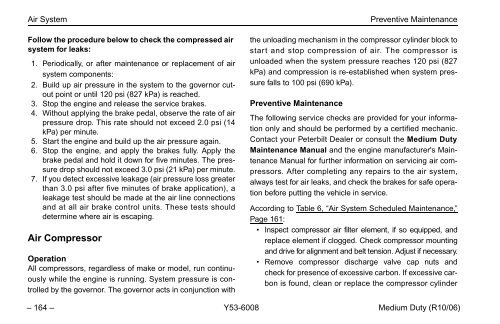Peterbilt Medium Duty Trucks Operator's Manual after 1-07
Peterbilt Medium Duty Trucks Operator's Manual after 1-07
Peterbilt Medium Duty Trucks Operator's Manual after 1-07
Create successful ePaper yourself
Turn your PDF publications into a flip-book with our unique Google optimized e-Paper software.
Air System<br />
Follow the procedure below to check the compressed air<br />
system for leaks:<br />
1. Periodically, or <strong>after</strong> maintenance or replacement of air<br />
system components:<br />
2. Build up air pressure in the system to the governor cutout<br />
point or until 120 psi (827 kPa) is reached.<br />
3. Stop the engine and release the service brakes.<br />
4. Without applying the brake pedal, observe the rate of air<br />
pressure drop. This rate should not exceed 2.0 psi (14<br />
kPa) per minute.<br />
5. Start the engine and build up the air pressure again.<br />
6. Stop the engine, and apply the brakes fully. Apply the<br />
brake pedal and hold it down for five minutes. The pressure<br />
drop should not exceed 3.0 psi (21 kPa) per minute.<br />
7. If you detect excessive leakage (air pressure loss greater<br />
than 3.0 psi <strong>after</strong> five minutes of brake application), a<br />
leakage test should be made at the air line connections<br />
and at all air brake control units. These tests should<br />
determine where air is escaping.<br />
Air Compressor<br />
Operation<br />
All compressors, regardless of make or model, run continuously<br />
while the engine is running. System pressure is controlled<br />
by the governor. The governor acts in conjunction with<br />
Preventive Maintenance<br />
the unloading mechanism in the compressor cylinder block to<br />
start and stop compression of air. The compressor is<br />
unloaded when the system pressure reaches 120 psi (827<br />
kPa) and compression is re-established when system pressure<br />
falls to 100 psi (690 kPa).<br />
Preventive Maintenance<br />
The following service checks are provided for your information<br />
only and should be performed by a certified mechanic.<br />
Contact your <strong>Peterbilt</strong> Dealer or consult the <strong>Medium</strong> <strong>Duty</strong><br />
Maintenance <strong>Manual</strong> and the engine manufacturer's Maintenance<br />
<strong>Manual</strong> for further information on servicing air compressors.<br />
After completing any repairs to the air system,<br />
always test for air leaks, and check the brakes for safe operation<br />
before putting the vehicle in service.<br />
According to Table 6, “Air System Scheduled Maintenance,”<br />
Page 161:<br />
• Inspect compressor air filter element, if so equipped, and<br />
replace element if clogged. Check compressor mounting<br />
and drive for alignment and belt tension. Adjust if necessary.<br />
• Remove compressor discharge valve cap nuts and<br />
check for presence of excessive carbon. If excessive carbon<br />
is found, clean or replace the compressor cylinder<br />
– 164 – Y53-6008 <strong>Medium</strong> <strong>Duty</strong> (R10/06)
















